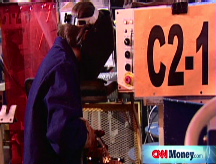More signs the world isn't ending
The economy is still weak but the latest job numbers prove once again that the worst may be over.

NEW YORK (CNNMoney.com) -- The worst-case scenarios just aren't playing out.
Yes, companies cut jobs again, we learned today, for the fourth straight month. In April, 20,000 jobs were lost, but economists on average expected a loss of 75,000 - some feared more than 100,000 cuts.
What's more, the unemployment rate dipped from 5.1% to 5%. Most thought it would tick higher.
We've had news like this all week. In short, the economy is in bad shape....but it's simply not as bad as a lot of people are making it out to be.
On Wednesday, an initial reading of the economy in the first quarter showed that the economy grew - not by a lot, but at least it didn't decline as many feared.
The Chicago PMI, a key gauge of the manufacturing sector, came in a bit higher than forecast, a possible sign that the worst may be over for that troubled industry. And the government reported today that factory orders for March rose 1.4%, much higher than expected.
Finally, the increase in personal spending for April was also a bit better than expected, showing that the consumer isn't dead.
"We've been gradually coming to the conclusion that the economy is in a bottoming phase. The data has been weak but not as bad as expected. That's a good scenario and we're feeling better," said Joe Balestrino, fixed income market strategist with Federated Investors, a money management firm based in Pittsburgh.
With all this in mind, the Fed's rate cut on Wednesday might be the last for some time. The central bank is highly unlikely to lower rates again at its next meeting in June and it could keep interest rates at 2% for the foreseeable future.
That's because inflation, and not necessarily more problems in the housing and credit markets, are probably now Public Enemy #1 for the Fed in the wake of soaring food and oil prices.
A prolonged Fed pause could help to strengthen the dollar - which has rallied against the euro in the past week - and take some of the speculative froth out of oil and other commodity prices. Crude oil is now trading at about $113, down from a record high of just under $120 a barrel earlier in the week.
"The Fed is doing the right thing on the policy front. If it doesn't need to bring rates below 2%, it shouldn't," said Steve Van Order, chief fixed income strategist with Calvert Funds in Bethesda, Md.
The latest developments on the macroeconomic front has Wall Street a little more enthusiastic about the economy. The Dow closed above 13,000 yesterday for the first time since early January and stocks gained more ground Friday morning.
In addition, bonds continue to fall, sending yields on the benchmark U.S. 10-Year Treasury note higher. The 10-year now yields about 3.85%, up from a low this year of 3.28%. (Bond yields and prices move in opposite directions and higher yields are usually a sign of a rebounding economy.)
Earnings from many companies, reported in the past month, also support the idea that the economy may hold up.
"Earnings in the first quarter, excluding financials, have been pretty darn good," Balestrino said. "There is not a lot of data to support the thesis that there is contagion in Corporate America from the credit crunch."
Of course, this doesn't mean the economy is out of the woods. The jobs market isn't likely to strengthen significantly anytime soon and the housing market is certainly still in sad shape. If we are at, or nearing, a bottom, we may stumble across it for awhile.
But overall, it's been a good week, one that may hopefully put to rest some of the more outlandish fears about an imminent economic collapse. This may turn out to be a longer recession than expected but one that is ultimately fairly mild.
"You can see the panic wave cresting and an attempt at stabilization," Van Order said. "We're moving through this but it may take longer to get through. But you've got to feel better than you did a month or two ago. There's less teeth grinding."
Issue #1 - America's Money: All this week at noon ET, CNN explains how the weakening economy affects you. Full coverage.
Under the government's economic stimulus plan, 130 million people will receive tax rebate checks for $300 and up, starting April 28. What do you plan to do with your check? How do you think the stimulus plan will affect the economy? Send us your photos and videos, or email us and tell us what you think. ![]()



